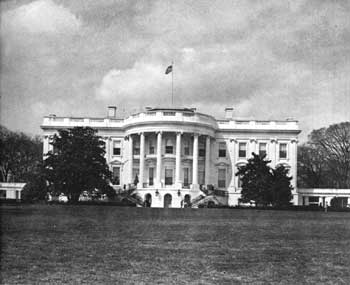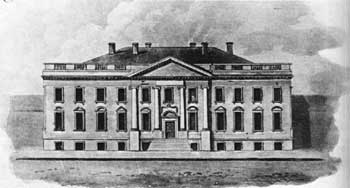







Survey of
Historic Sites and Buildings
 |
The White House District of Columbia |
 The White House |
| ||
Signers John Adams and Thomas Jefferson were the first two occupants of the White House, official residence of our Nation's Presidents since 1800. It is a national shrine that symbolizes the honor and dignity of the highest office in the land, and has been the scene of many historic events and brilliant social affairs. Like the Nation itself, it bears the influences of successive Chief Executives. Although rebuilt and modernized, it retains the simplicity and charm of its original appearance.
President George Washington approved the plans for the White House, drawn by Irish-born James Hoban, winner of the prize competition. Maj. Pierre Charles L'Enfant, the French artist-engineer, located the mansion in his plan of the Federal City, in which it and the Capitol were the first public buildings erected. The cornerstone was laid on October 13, 1792. Workmen used light gray sandstone from the Aquia Creek Quarries, in Virginia, for the exterior walls. During the course of construction or soon thereafter, they apparently were painted white. The building was thus unofficially termed the "White House" from an early date, but for many years it was usually referred to as the "President's House" or the "President's Palace."
 |
| South facade of the White House. (National Park Service, Abbie Rowe) |
In the Palladian style of architecture, the main facade resembles the Duke of Leinster's mansion in Dublin. Hoban probably derived the details of other faces and the interior arrangement from other contemporary European mansions. He supervised the original construction; the rebuilding after the burning by British forces, in 1814; and the erection of the north and south porticoes, some years later. Over the course of time, however, various architects modified Hoban's original plans, notably Benjamin H. Latrobe during and after the Jefferson administration.
President and Mrs. John Adams were the first occupants, in November 1800 when the Government moved from Philadelphia to Washington. The interior had not yet been completed, and Mrs. Adams used the unfinished East Room to dry the family wash. During Jefferson's administration the east and west terraces, or pavilions, were built. Jefferson, who practiced democratic simplicity in his social life, opened the mansion each morning to all arrivals.
During the War of 1812, British forces captured the city and set the torch to the White House, the Capitol, and other Government buildings in retaliation for the destruction by U.S. troops of some public buildings in Canada. Only the partially damaged exterior walls and interior brickwork of the White House remained in the spring of 1815 when reconstruction began. In 1817 the recently elected President, James Monroe, was able to occupy the structure. In 1824 builders erected the south portico; and in 1829, the large north portico over the entrance and driveway. The west wing, including the President's oval office, was added during the first decade of the 20th century. The east wing was built in 1942.
 |
| North facade of the White House in 1807. (Aquatint; by an unknown artist, from Charles. W. Johnson, The Stranger in America, 1807, Library of Congress.) |
Over the years, the White House proper has been extensively renovated and modernized on various occasions. The old sandstone walls have been retained, however. The aim has been to keep the historical atmosphere while providing a more livable home for the President and his family.
Located on the first floor of the main building are the East Room, Green Room, Blue Room, Red Room, State Dining Room, and Family Dining Room. These richly furnished rooms have historically been open to the public on a special schedule. The ground and second floors are restricted to the use of the presidential family and guests. On the ground floor are the Diplomatic Reception Room, Curator's Office, Vermeil Room, China Room, and Library. The second floor contains the Lincoln Bedroom, Lincoln Sitting Room, Queens' Bedroom (Rose Guest Room), Treaty Room, Yellow Oval Room, and Empire Guest Room. Neither of the wings, reserved for the President and his staff, are ordinarily accessible to the public.
The simple dignity of the White House is enhanced by the natural beauty of its informal but carefully landscaped grounds.
 |
 |
http://www.cr.nps.gov/history/online_books/declaration/site6.htm
Last Updated: 04-Jul-2004